Independence Hall, Congress Hall, Old City Hall
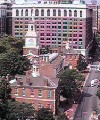
The three buildings, seen from the south
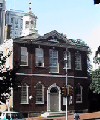
Old City Hall
Let's start at Old City Hall. The building was erected between 1789 and 1791. It was first intended for use as City Hall, but from 1791 to 1800 it housed the United States Supreme Court, which was presided over by John Jay until 1795. It served as Philadelphia's City Hall from 1800 to 1874, when the city government moved to the present site, covered in the Virtual Walking Tour of Center City.
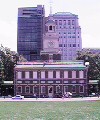
Independence Hall
The State House or, as it is popularly known, Independence Hall, was begun in 1732 and considered finished by 1756 as the Pennsylvania State House. Its architects are thought to have been Edmund Woolley and Andrew Hamilton. Until 1799 the building served as the meeting place of the provincial and state governments. The Second Continental Congress met here. The Articles of Confederation were drafted and ratified here. And, the stormy sessions of the Constitutional Convention, presided over by Washington, were also held here.
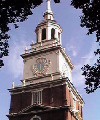
The spire of Independence Hall
The present spire which tops the tower proper was added by William Strickland in the restoration of 1828 — a fact not generally known.
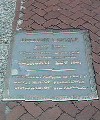
Bronze plaque
Before entering the Hall, note two bronze markers in the flagstone pavement; one commemorates the flag-raising here by Abraham Lincoln (pictured), February 22, 1861. The flag he raised had 34 stars, the last one for Kansas, which had just been admitted to the Union. The other marker is to John Fitzgerald Kennedy, who spoke on the spot July 4, 1962.
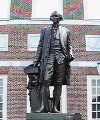
Statue of Washington
In front of the entrance itself is a familiar statue of Washington erected in 1869. Philadelphia schoolchildren, beginning in 1860, gave their pennies to pay for it.
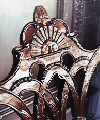
Washington's "Rising Sun" chair
To the left of the entrance hall is the Pennsylvania Assembly Room. Here the delegates from the thirteen colonies gathered and by July 4, 1776, had adopted the Declaration of Independence.
The most important treasures in the room are the chair used by Washington during the Constitutional Convention, with its rising sun carved on its back and the silver inkstand designed by Philip Syng, used for the signing of both the Declaration of Independence and the Constitution. The room has been restored to its appearance at the time of the signing and the chairs, tables and writing equipment are of the period.
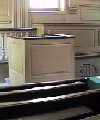
Supreme Court
Across the hall is the Pennsylvania Supreme Court Chamber with its handsome ochre-painted walls and the coat of arms of the Commonwealth above the bench. There are a prisoner's dock and jury boxes. Prisoners stood in the dock throughout the course of their court proceedings — giving rise to the expression "stand trial."
The visitor should ascend the tower staircase slowly to savor the beauty, the simplicity and the elegance of the tower itself, with its Palladian window facing the old square and framing the statue of Commodore John Barry, "The Father of the American Navy," standing among the ancient trees.
To the left on the second floor is the Governor's Council Chamber, its windows enhanced by blue shades and valances. The eight chairs and the armchair surrounding the table are complemented by eight silver candlesticks. This is the chamber where William Penn's sons and grandsons, or their appointed representatives, presided over the Provincial Council, the highest legislative body in the colony.
Amid elegant surroundings the Royal Governor officially received members of the Pennsylvania Assembly, foreign dignitaries and Indian delegations. The events of 1776 brought an end to the Provincial Council, but similar authority was vested in a Supreme Executive council over which Franklin presided from 1785 to 1788. The room has all the richness of the 18th century, but, with it, directness and simplicity, too. It was a working council room, with its grandfather's clock, telescope and two terrestrial globes.
The Long Gallery, which dominates the second floor, is flooded with north light from nine windows overlooking the three-block-long vista of Independence Mall. The chamber, when completed in 1745, was the largest public room in the Province of Pennsylvania. Suppers, balls and Grand Illuminations were held here to honor the great or mark public events.
In 1777 the British occupied the state house and converted these rooms into hospital wards for captured and wounded soldiers. The other room on this floor is the Committee or Assembly's Chamber. From 1747 to 1752 it served as a combined committee room and library for the Pennsylvania Assembly. It was then given over to the militia of the city of Philadelphia for the storage of supplies and small arms. In 1775 the Pennsylvania Assembly temporarily convened here, while the first floor chamber was occupied by the Continental Congress.
Independence Hall was used for parties in the 19th century, and among those so honored here were Lafayette, Henry Clay and Presidents Jackson, Van Buren, William Henry Harrison, Tyler, Polk, Fillmore, Pierce and Buchanan. Among those illustrious Americans who have lain in state here are Lincoln, Henry Clay, John Quincy Adams and the Arctic explorer, Elisha Kent Kane.
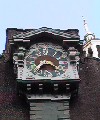
Clock tower
Descending to the first floor, leave Independence Hall by the south door, which gives onto the square. In 1972 the National Park Service replaced the great outdoor clock, which was originally set into the west wall in 1752 and removed in 1828. A 14-foot carved replica of the remarkable clock head was installed on top of the 40-foot soapstone case structure.
The hurried visitor may rush on, but linger if you can — saunter about the winding paving-stone paths and look at the Hall from the vantage point of the square. The proportions of the tower alone delight the eye, the symmetry of the building — in fact of the entire complex of buildings — is a tribute to the artisans and men who built it. Here is the balance and order of the 18th century at its apogee.
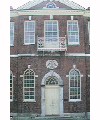
Congress Hall
And when we speak of these qualities, in some ways the epitome is yet to be seen. For, in Congress Hall, on the northwest corner of the square, is the distillation of all that was fine in the architecture of that remarkable time. It is small, self-contained, functional and beautiful.
Congress Hall, constructed 1787-1789 as the Philadelphia County Court House, served as the meeting place of the Federal Congress from 1790 until 1800, when Philadelphia was the capital of the United States. Later in the 19th century it housed federal and local courts. Perhaps its most historic associations are Washington's inauguration here for his second term as President and John Adams' taking of his oath as President in 1797.
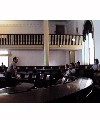
Congress Hall
On the first floor is the House of Representatives Chamber. The valances of dark green above the windows enhance the mahogany of the desks and the studded leather chairs. In the south bay is an alcove where Representatives smoked and had a glass of sherry, port or madeira during the recess.
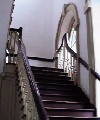
Inside Congress Hall
The staircases, right and left of the fan-lighted door, are steep but they lead the visitor on to unexpected pleasures. The second-story landing, with the brass and glass lantern suspended above it, looks north as does the Long Gallery in Independence Hall. Here, however, the windows are larger and there is a sense of being airborne when looking from them.
If the effect is too dizzying, there is a handsome settle on which to sit and look down the hall to the Senate Chamber. What the eye sees from this prospect is the small dais with its exquisite canopy in rich crimson. It is, in truth, a miniature throne. The chamber itself, with its matching valances framing the Venetian blinds, the deep red leather of the chairs and again the mahogany of the desks, is one of the most perfect rooms to be found anywhere. It was a stage setting for the Senate debates.
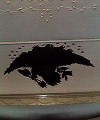
Eagle fresco
And to add further esprit there is an 18th-century fresco of an eagle, and the plaster beading on the ceiling — both elegant touches. An even smaller visitors' balcony than the one in the House of Representatives chamber overlooks the Senate.
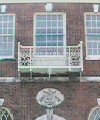
Congress Hall
On leaving Congress Hall by the front door, turn and study for a moment the perfectly proportioned windows, the door, its fan light and the tiny iron balcony above.
Independence Hall Area
- Welcome to the Independence Hall Area
- Welcome Park
- City Tavern
- Merchant's Exchange
- First Bank of the United States
- Old Visitor Center
- Bishop White House
- Walnut Street Garden and Houses
- The Philadelphia Contributionship
- Todd House (Dolley Madison)
- Carpenters' Hall
- New Hall (Military Museum)
- Pemberton House
- Franklin Court
- Second Bank
- Library Hall
- Philosophical Hall
- Independence Square
- Independence Hall, Congress Hall, Old City Hall
- Atwater Kent Museum
- Graff House
- President's House
- Liberty Bell


